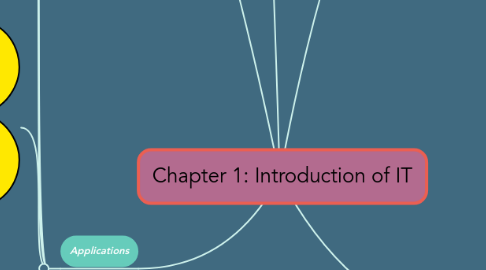
1. Applications
1.1. FINANCE
1.1.1. FINANCE INVESTMENT SYSTEM ~ Inventors buy & sell stockand bond online without using broker
1.1.2. ONLINE BANKING SYSTEM ~ To pay bils,track personal income,and expenses,manage investment and evaluate financial plans
1.2. EDUCATION
1.2.1. LEARNING MANAGEMENT SYSTEM~ Students can get their lecture note,answerquizzes and submit assignment by using learning management system
1.2.2. COMPUTER BASED TRAINING ~ Uses computer - uses computer-generated visuals or environment for training such as flight simulator used by pilots before flying new plane or different types of plane
1.3. GOVERNMENT
1.3.1. E-FILING ~ Online system for declaring tax
1.3.2. E-SYARIAH ~ Online portal for providing information about the rules and procedures of the court
1.3.3. HRMIS ~ Online system for updating government employee information
1.4. HEALTH CARE
1.4.1. MEDLINE ~ Many websites provide up-to-date medical fitness,nutrition or exercise information
1.4.2. COUNTER REGISTRATION SYSTEM ~ Hospitals and doctors use computers and mobile devices to maintain and access patient record
1.4.3. TELEMEDICINE ~ Health care professionals in separate locations conduct live conference in the computer
1.4.4. TELESURGERY ~ Surgeon performs an operation on a patient who is not located in the same physical room as the surgeon
1.5. SCIENCE
1.5.1. VIRTUAL REALITY ~ Use of computers simulate a real or imagined environment that appears as 3D space
1.5.2. COCHLEAR ~ Use of computer technology to help user in hearing problem
1.5.3. HAWK EYE OFFICIATING SYSTEM ~ Complex computer targeting system thai is used to track the path an object thai is being developed for use in sports such as tennis and football
1.5.4. NEURAL NETWORK ~ A system that attempt to imitate the behavior of human brain
1.6. PUBLISHING
1.6.1. ONLINE NEWSPAPER & MAGAZINE ~ Allow user to get information easily by rerading newspaper & magazine online
1.7. TRAVEL
1.7.1. GLOBAL POSITIONING SYSTEM (GPS) ~ IT application that helps users to trackroutes for specific location
1.7.2. ONLINE RESERVATION SYSTEM ~ Transportation and accommodation reservation can be done through website
1.7.3. E-TICKETING ~ Online booking ticket
1.8. MANUFACTURING
1.8.1. COMPUTER-AIDED DESIGN ~ Use of computer systems to increase designer productivity and design quality
1.8.2. COMPUTER AIDED MANUFACTURING ~ Controls machine tools,mainly robot arms, in high tech assembly line. It used to speed up and improve accuracy of the process for task
2. Categories of Computers (Characteristic & Capabilities)
2.1. SUPERCOMPUTER
2.1.1. PHYSICAL SIZE ~ Size of supercomputer occupy a full room of equipment
2.1.2. SPEED ~ Tens of thousands of processors
2.1.3. STORAGE (REFERRING TO MEMORY) ~ Extremely large storage
2.2. MAINFRAME
2.2.1. PHYSICAL SIZE ~ Size of mainframe occupy partial room to a full room of equipment
2.2.2. SPEED ~ Dozens of processors
2.2.3. STORAGE (REFERRING TO MEMORY) ~ Very large & addable storage
2.3. PERSONAL COMPUTER
2.3.1. PHYSICAL SIZE ~ The size of personal computer fiits on a desk
2.3.2. SPEED ~ Single processor
2.3.3. STORAGE (REFERRING TO MEMORY) ~ Large
2.4. MOBILE COMPUTER
2.4.1. PHYSICAL SIZE ~ The size of mobile computer fits on your lap or in your hand
2.5. MOBILE DEVICES
2.5.1. PHYSICAL SIZE ~ Mobile devices such as smart phone size is fits in the palm of your hand or a pocket size
2.6. EMBEDDED COMPUTERS
2.6.1. PHYSICAL SIZE ~ Miniature. It is mounted on a circuit board and then installed in a machine or appliance using wires to carry input and output signals

